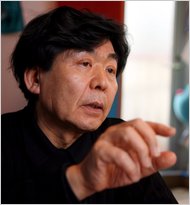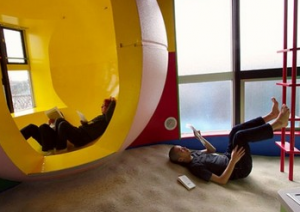
The Helen Keller “Reversible Destiny” Loft.
(Credit: archdaily)
Japanese designer Shusaku Arakawa (1936-2010) declared that he and his partner Madeline Gins would never die. The duo pushed the boundaries of design for over 40 years, melding philosophy with architecture in buildings like Bioscleave House until Arakawa’s death at the age of 73. Built on Long Island, Bioscleave House served as sort sanctuary for health benefits that combatted death, says Ms. Gins, who explained that “Its architecture makes people use their bodies in unexpected ways to maintain equilibrium, stimulat[ing] their immune systems.” It’s a design philosophy that ties into the couples’ now famous mantra and namesake: Reversible Destiny.
“Reversible Destiny” is the duo’s response to our mortality – a protesting fist in the face of our inevitable death. “It’s immoral that people have to die,” says Ms. Gins, who spent more than $2 million dollars constructing the couple’s Long Island domain. The two have worked to develop “an arcane philosophy of life and art, a theory [with roots in] in treatises, paintings, books and now built projects like this one — to outlaw aging and its consequences,” said The New York Times.
““Reversible Destiny” is the duo’s response to our mortality – a protesting fist in the face of our inevitable death.”
What makes Bioscleave positively challenge, and improve, our health? With an undulating floor and a bright palette of colours, the abode literally and figuratively pushes the boundaries of our senses. “Level changes induce the sensation of being in two places at once, [while some] windows seem too high or too low.” The floors feel like a sand dune and there are almost no doors in the house – making privacy a precious commodity. The idea is that living in and adapting to such an unrelenting space keeps us young, says Arakawa, and architect Steven Holl agrees: “It has to do with the idea that you’re only as old as you think you are,” he said to The New York Times.
Some of the earliest seeds of Arkawa and Gin’s philosophy can be found in their proposal for the “City of Reversible Destiny.” Designed for the city of Tokyo in 1998 competition, Reversible Destiny envisioned a series of apartments that would be built on a 75 acre landfill. Although the “city” was never made, it prompted the public to consider challenging death through our everyday living circumstances. What could happen if we lived in a new kind of community, one within an innovative space of art and design? For Arakawa, Reversible Destiny isn’t just a philosophy; it’s the next step in human health. A series of apartments designed by the couple in Mitaka, Japan have received nothing but accolades from its inhabitants, including an elderly couple who declared that they’d never felt healthier after having to move around on the ground – like snakes, they said said – to get from room to room.
Recently, Reversible Destiny has inspired the construction of lofts that give life to admirable men and women of history who have passed away, such as Helen Keller. They “invite optimistic and constructive action,” says Arch Daily, creating a space for others to live healthier in an environment dedicated to the memory of someone who has already passed away.
Related Articles:
- Arch Daily’s article on Shusaku Arakawa
- The New York Times’ obituary for Shusaku Arakawa
- Or, explore the insides of the Reversible Destiny lofts in depth here

 The Reversible Destiny Foundation: Architecture as an Extension of Life After Death
The Reversible Destiny Foundation: Architecture as an Extension of Life After Death





 John Mulaney’s “Funeral Planning” on Netflix: No Real Plan
John Mulaney’s “Funeral Planning” on Netflix: No Real Plan

 Composting Bodies Is Now Legal in a Dozen States
Composting Bodies Is Now Legal in a Dozen States














